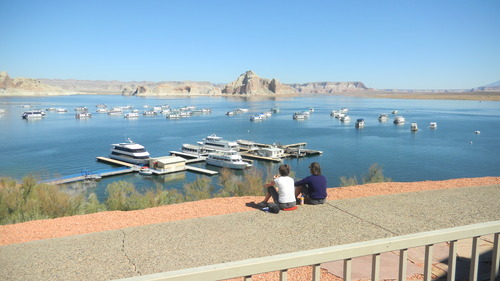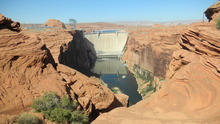This is an archived article that was published on sltrib.com in 2011, and information in the article may be outdated. It is provided only for personal research purposes and may not be reprinted.
Some say Lake Powell and Lake Mead are slowly dying.
Others maintain the Colorado River reservoirs, two of North America's largest, are doing just fine. These experts say they not only meet current needs but have the potential for pipelines that bring water into Denver and St. George as well as a nuclear power plant on the Green River.
How the water is managed over coming years has enormous consequences for the West. At stake are the growth potential for many major Western cities that rely on Colorado River water for drinking, crops grown in California, cheap hydroelectric power, recreation enjoyed by millions each year, the ecological health of the Grand Canyon and the survival of several endangered fish.
"Everyone predicts that Lake Powell's days are numbered," said Dan McCool, professor of political science and environmental studies at the University of Utah, adding that all models looking at climate change indicate that it is going to get drier and warmer in the Colorado River Basin, reducing future flows.
In 2007, Western states and the federal government signed an agreement specifying what happens when water is in short supply. When the level of Lake Mead drops below a certain elevation, more water is released from Lake Powell in a process called equalization.
In its latest study, the Bureau of Reclamation (BOR), which manages the system, put the probability of a 2011 equalization release from Lake Powell to Lake Mead at 97 percent. The release will likely be 11.63-million acre-feet instead of the usual 8.23 million, about 40 percent more than usual. The final decision won't be made until April. If the release occurs as expected, there likely won't be a water shortage in the lower basin states of Nevada, Arizona and California in 2012.
A 10-year drought has caused Mead to recede, forcing the probable equalization. Those opposed to equalization say that, ultimately, it causes Utah and other upper-basin states to lose out on their share of the Colorado River, thus impeding their growth.
The situation could get worse.
A 2008 study by research marine physicist Tim Barnett and climate scientist David Pierce of the Scripps Institution of Oceanography concludes there is a 50 percent chance that Lake Mead will be dry by 2021 if the climate changes as expected and future water usage is not curtailed. That could affect the water supplies of between 12 million and 36 million people as a net deficit of nearly 1 million acre-feet of water per year from the Colorado River system continues.
"It is inevitable that some time in the next few decades, various states of the West will have to make some extremely tough decisions," said Jack Schmidt, a river expert and professor at Utah State University. "There are well respected, serious studies done that look at water-use patterns and climate change. They predict the probability that Mead and Powell will both approach going dry for a few years and, in wet years, fill back up. They will get lower than they already have. That is inevitable"
Schmidt said that could create a societal nightmare in the lower basin with water use curtailed.
Rick Clayton, a hydraulic engineer in the water resources group of the Bureau of Reclamation, strongly disagrees that the Colorado River cannot meet current and future water needs or that Lake Mead, Lake Powell or both may eventually disappear.
He said that during the current 10-year drought — which could be ending this year with the latest models showing above-average snowpack in the Colorado Basin — Powell and Mead have operated as planned. Although both reached low levels, they continue to produce electricity and provide water.
"The way we operate the system can react to dry conditions when they occur," said Clayton. "For that reason, we will be able to sustain the system. It is complicated, but from where I sit, the system is functioning as it was intended when it was designed. We are able to react as appropriate to changing conditions."
But he does say that if conditions were to remain dry for another 10 or 20 years, the states and the Bureau of Reclamation might need to revisit current policy and make adjustments in order to preserve storage in reservoirs.
Clayton said upper-basin states Wyoming, Colorado, Utah and New Mexico can continue to develop their share of the Colorado River.
"We believe we can manage the system to provide that water," Clayton said, noting the lower basin already is fully developed.
Paul Ostapuk, a board member for Friends of Lake Powell based in Page, Ariz., said his group had long been in favor of the 2007 agreement.
"It evens off over the long run," he said. "When we get to low like we did earlier in this decade and Mead was higher, there were provisions in there to slow the flow. The reverse is happening now. With all the gloom and doom about the Colorado River, if runoff is 85 percent of normal or above, Lake Powell rises. If we get a couple of normal years, things will improve more than they have."
But what is "normal?"
"Normal is in many cases abnormal," said McCool. "There is no normal. There are changes and because of climate change, the change will be radical. They say we are in an 11-year drought. Maybe we are just in 11 years of reality and there will always be a drought. We live in a desert and drought is permanent."
Is there a better way to manage the reservoirs?
Richard Ingrebretsen, president of the Salt Lake-based Glen Canyon Institute, which has advocated draining Lake Powell, said that using all of Powell's water to preserve Lake Mead is the way to go.
"Keep Mead full and use Powell as a backup," he said. "You will save water and restore these beautiful rivers. Keep the [Glen Canyon] dam there to keep some water in Powell some of the time. And restore rivers for long term use. ... They [the Bureau of Reclamation] don't need Lake Powell. They need Lake Mead. This spring, with the equalization that has never been done before, you are setting a huge precedent sending the water down from Powell to Mead."
Schmidt has similar thoughts.
"Among the things that we could ask ourselves if we wanted to be really innovative is whether it makes more sense to store the majority of water in Mead and have Powell be secondary," said the Utah State professor. "Or should Powell be primary and Mead the secondary site? Or should we manage both with equal contents? We don't ask those questions."
With potential climate change and the demands on Colorado River water increasing throughout the West, more experts are seeking answers.
"Serious scientists are doing these studies," said Schmidt. "Water managers, be they conservatives or liberals, all take this utterly seriously. They are not in the business of talk-radio climate change denial. They are in the business of managing water supplies in the Western U.S. And they take it utterly seriously because it would be grossly irresponsible not to."
Boating at Lake Powell
Using Lake Powell water to help keep Lake Mead levels up is not expected to dramatically affect boating at Lake Powell this year.
Part of the reason is the overall snowpack above Lake Powell on Feb. 9 was 124 percent of average. The Castle Rock Cutoff on the lower end of the reservoir, a shortcut for boaters going north from Wahweap, is usable until Lake Powell's water level drops to 3,608 feet. National Park Service spokesperson Veronica Lane said there is currently a "soft closure" at Castle Rock. It is not safe for houseboats and many ski boats. Depending on how much water comes into Lake Powell from spring runoff, it could open later in the year. —
The Place No One Knew
In 1963 when Lake Powell began to cover Glen Canyon, the Sierra Club published a book called The Place No One Knew about the wonders that were inundated by the reservoir. In 2005, Lake Powell dropped to 35 percent of capacity, allowing some famous features such as The Cathedral in the Desert to be partially exposed again.
Roy Webb, an archivist at the University of Utah's Marriott Library Special Collections, said that people actually did know Glen Canyon. The library has preserved over 8,000 images and thousands of feet of film about what the canyon looked like before Lake Powell.
What might the canyon look like if the reservoir dropped even further than it did in 2005? "While it might never be the same, the river is a lot stronger than we give it credit for," said Webb, an author and avid river runner. "Nature and the environment would clean it out. Things that have been under water would be somewhat changed. But it would come back really quickly. If that [the reservoir drying up] happened, I'd be first in line to go down there."
Among the famous sites drowned by Lake Powell, Webb said were the Music Temple, the water wheel at the Olympia Bar, Hite's Cabin, Bert Loper's hermitage, the Crossing of the Fathers, Hole in the Rock and Stanton's Dredge. Ancient Indian ruins and inscriptions probably would be gone.









